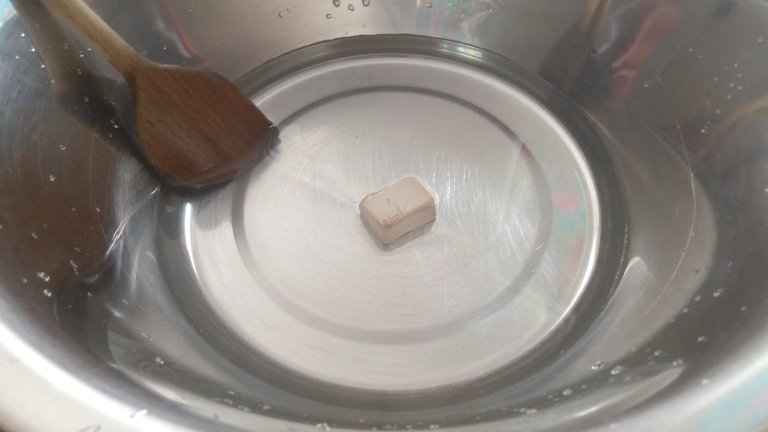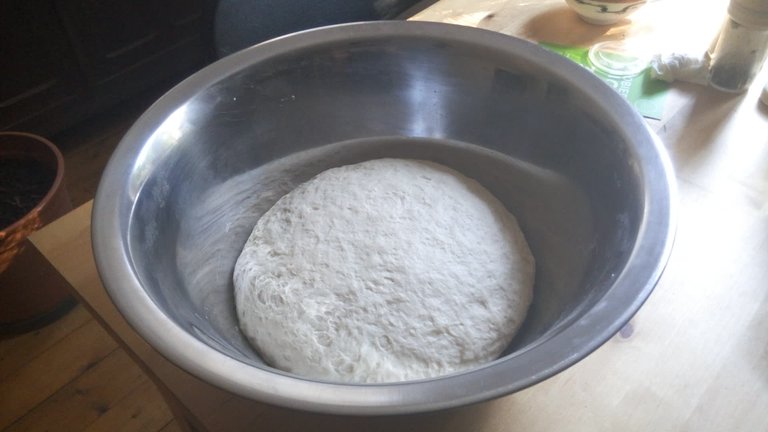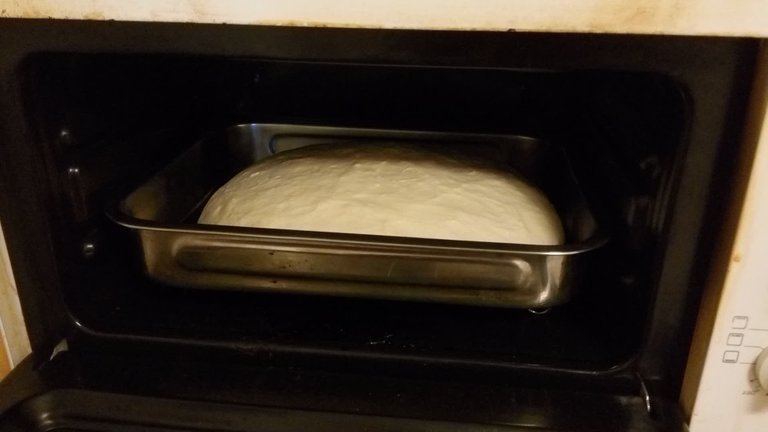Originally posted on my Blog:
manerosss.wordpress.com
Hi!
In this post I'm going to explain how to make bread at home with this easy recipe.

But why making a bread?
Couldn't I simply eat some flour without making a dough, let it rise to than bake it?
Yes you could, but good luck digesting it!
In fact we can't digest most of it unless cooked, that's true for every other cereals and their flours.
We have no enzymes to easily break the starch structure, therefore we need to cook these cereals to better assimilate them.
Have you ever seen someone eating uncooked rice?
Other than carbohydrates (starch), cereals contain proteins. Some of these proteins create gluten, but not all cereals have gluten.
The gluten that make the dough rise is found in wheat, oat, rye, barley and related species and hybrids.
The process is simple:
Yeast loves carbohydrates and eats them. By doing that the starch structure is broken up, this process creates air.
By making a dough we also stimulate the gluten to tie together, this create a net that is able to hold down the air caused by the yeast, so that the dough rise.
A well raised dough is easier to cook and therefore easier to digest.
It may happened that after eating a pizza for dinner you woke up at night or in the morning desperate for water...
That's because the dough wasn't properly cooked, thus harder to digest.
This should explain what's going on while making bread, I'll be more specific in the next posts where I'll talk about sourdough, non-wheat or mixed breads and you'll see the starch separated from the proteins when I'll post on how to make Seitan.
For this recipe I’m using wheat flour and fresh yeast, the quantities are as follow:
- 1kg Soft Flour
- 550ml Water
- 25g Salt
- 25g Fresh Yeast (here I’m using 10g)


Here is a grid that lists how the flours are named in different countries:

The fist row is the cheapest and easier-to-use flour, I normally use wholemeal flour as it’s more nutrient, but I suggest you not to and to stick with soft flour or plain flour for the first breads.
Soft wheat flour is easier to work so to create the gluten net to hold the air, therefore it’s most likely that the dough will rise without surprises.
---
When dealing with quantities, and you're not sure how much water to use, start by adding water to match half the quantity of flour. If you have 400g flour then add 200ml water and then slowly add water to reach the desired texture.
By experimenting with other flour types you'll see that the less refined a flour is the more water it needs.
Another key feature when making the dough rise is the amount of yeast used and the overall temperature.
You can control the rising to suit your busy day, for example you can make a dough in the morning and then bake it at evening when you get back home from the workday.
Yeast loves a temperature between 30-50°C and works best in that range, but be aware that it dies if going above 55°C.
This means that the dough will rise faster as the yeast finds its optimal environment.
The easiest way to control this factor is by using cold or warm water, store the dough in a specific place.

Salt is a key ingredient not just for the taste but also because it gives the dough a good compact texture.
Please always remember that salt and yeast are archenemies as salt kills yeast, therefore be careful not to mix them together.
I guess I can start showing the actual recipe now :)
To facilitate the mixing I'm using a metallic bowl and a wood spoon.

As said salt and yeast don’t go together, what I normally do is dissolving salt in the water, alternatively you can mix salt with the flour.

If you have no scale to measure the ingredients, this is roughly 7-8g of salt, I always use as less scale, cups or spoons as possible and try to measure everything with my eyes

When the salt is fully dissolved you can add the yeast

Now if you wait a few minutes the yeast is going to become softer and it starts to dissolve by itself

Once fully dissolved you can add the flour (in other guides I'm going to show you another method to incorporate more air into the flour)

And start mixing the ingredients

Then use your hands to create a ball and work it for some minutes so that the gluten net is forming and the dough's temperature rises.
You can use the dough as a sponge to clean the bowl as I did here.

At this point cover the bowl and let it rest for 30 minutes - 1 hour

After that the dough should have raised and you're ready to move it

I have a crappy oven so I always put my dough on a baking tray with a bit of oil
If you want to cut the dough you can do it now or later, before baking it.


And I let it rest in the oven for 3-4 hours (until it’s at least twice the volume)
As I previously explained this process depends on the dough and environment temperature and on the amount of yeast used.



As you can see the dough is huge, this is typical with this kind of flour.
By working with less refined or other cereal flours you’ll notice the difference, they won’t be able to hold as much air and they’ll release it from small holes on the surface.
Now it’s time to bake it!
Pull out the dough and turn on the oven at 200°C for 30-40 minutes
I cut the bread just before putting it in, this lowered the dough a bit, I actually thought it would’ve been able to raise more during the baking process but it didn’t.

This is not a big deal, but if you have a crappy oven like mine you can try to turn on the oven without pulling the dough out.
Or you can also bake it without cuts, if you do so check out that the bread’s surface doesn’t burn too much.
This is how it looks when it’s done

If you used a baking tray and the bread doesn’t come out you can turn it upside down, cover it with a cloth and wait a few minutes, the hot air goes up and will unstick the bread.


Enjoy your bread!

TA SALÜDE
In Hungary we say for that "punya" or "vakaró"!
It looks great!
Yum, compliments!
Thanks for sharing your recipe. Have you ever thought of making your own sourdough? Personally, I love the taste of sourdough and it prevents the effects of the phytic acid and makes the bread easier for us to digest.
yeah I also make my own sourdough, I'm going to post about it soon :)
Nice! I really love steamy homemade bread and that smell it has! It was never easy for me to prepare it, but always pleasure eating one! :D
It's worth learning though, there are unlimited combinations to try out: mixing flours, using seeds, potatoes, sweet breads and so on.
Also with this dough recipe you can also make focaccia and pizza in teglia (sheet pan pizza) just to name a few.
Once you learn the technique it's going to stay with you forever ;)
I am actually doing this tomorrow! You have got me inspired! You know in my country bread making is a traditional activity that comes a long time ago! When I do this I am going to write one article and definitely show it to you!
Great post! I love learning new and useful recipes.
great guide, thanks for sharing
Could you do this in a big enough toaster oven? Enquiring budget minded individuals must know!
I'll love to do that but I have no other oven than the one you see in the pictures.
Anyway that's very close to a toaster oven, I think you'll have no issues by baking breads with your cheap oven.
Just be sure to turn it and check that the baking is uniform on all sides, there can be a big temperature difference if the oven's window is thin and not well insulated.